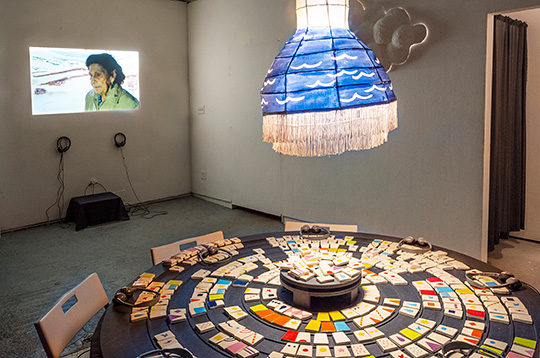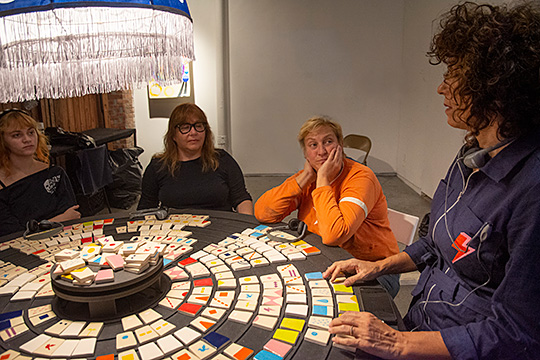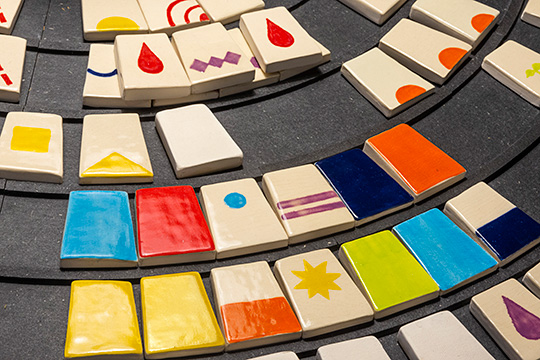 print preview
print previewback GEORGE FERRANDI
To Witness, Honor, and Play
Jason Anthony, a scholar of the intersection of ritual space and game space,
describes a fall 2022 experience of we are each other’s atmosphere.
The space is a baldfaced invitation to play. Eight chairs are pulled up to the central artifact, which brings to mind the lucky eight sides of a Mah Jongg table, despite being round as a planet. We sit in our places and while the tabletop is a black foam, its texture mimics to the fingers the green baize of Las Vegas. The tiles imply a game of chance that has not been invented yet, and overhead, the fringed lamp gives Western Saloon.
 |
| maybe the sun Installation view with projected still from This World Photo by Stefan Hagan |
we are each other’s atmosphere had been phrased to me as a kind of pandemic reckoning. America has done very little in that way, in spite of the lives lost, weddings canceled, careers derailed. In 1863, Abraham Lincoln called for a day of “humiliation, prayer and fasting” to engage with the psychological horror of the Civil War. To this day, the United Kingdom observes two minutes of silence on November 11 to process the victims of the War to End All Wars and those of wars that followed it. Pandemics have no such ritual language, though the burden of remorse they bring can be larger and less discriminating.
As we put on the headsets the fingers itch, almost immediately, to turn over tiles. The language of a game is both familiar and irresistible. We will find our best hand. We lay down stakes, without knowing a single rule. We will configure, we will construct, and we will aim to come out on top.
 |
| we are each other’s atmosphere Performance still by Stefan Hagan |
~
The intersectional space of art, ritual and formal games exists within an academic tradition that has only recently begun to process its lines of interrogation. Yet the subject matter exists in plain sight.
Take the ball court at Coba, one of the best preserved and extensive Mayan ruins. The site boasts more than 1200 sculptural pieces, lining the sporting field with the animals and crops on which the culture’s religious and daily life hinged. Yet it is a setting for games. Players of ulamitztli wore ornate dress and, through their play, echoed a performance of the cosmic game itself as it was once played by the twin gods Hunahpu and Xbalanque against the lords of death. Aesthetics, play and ritual became indistinguishable, especially when players ritually sacrificed after a game, an action captured by courtside sculptures in the ruins of Yaxchilan and Chichen Itza.
In the Western tradition, look no further than the Athenian Dionysia. Central to the ritual honors of the god was a gathering of the city’s composers and poets. Here, a competition of dithyrambic song in honor of the god had become so fiercely fought, that its innovations created the western theatrical tradition. The combination of ritual, game and art are fused etymologically in the word tragedy, meaning “goat song”—perhaps once a prize, or a sacrifice performed in honor of those who played in the game of the songs beloved by the god of wine and ecstasy.
There is undoubtedly modern consternation about games, art and ritual existing in shared space. Anthropologist Claude Levi-Strauss, crusader of absolute structural forms, drew a firm line around ritual through which games could not pass. Games end with a disjunctive separation of winners and losers, he wrote. Ritual—and art—end in a conjunctive sense of union. How many centuries of tradition did Levi-Strauss and the scholarship that followed have to ignore to come up with this formulation? And what ritual does not deal, in some sense, with gain and loss, victory and defeat?
~
Through the headsets on the table we are coached along. Our hands move over the tiles with growing fluency. We have mapped personal meaning to the images we touch with fingertips. We have placed an ante in the middle of the table, as in poker, reminded by the tape that “ante means ‘before’ in Latin. Time in lockdown made us lose track of months, even years, but one point on the pandemic timeline remains clear: there was a before.”
I have hardly sized up my fellow players. But soon the task is to turn over a tile for each statement about the COVID-19 lockdowns that personally resonates. It is impossible not to notice when the person to your left flips over a piece, when the table flips over pieces and you alone sit quiet, when you flip a piece and the table watches. The statements recount a litany of loss and disruption:
“…We worked from home. We retired early. We put our lives at risk for work. We postponed the trip for work. We postponed our vacation. We postponed our wedding. We missed our big birthday. We broke beloved traditions. We wiped down each orange. We witnessed trucks storing bodies in parking lots. We stopped clapping. Our hair grew long. Our shoes gathered dust . . .”
 |
| maybe the sun Post-performance installation view by Stefan Hagan |
In the tally of grief, who has won and who has lost? Eventually we shift tiles between players in a complex pattern and with that a sense of individual grief becomes, itself, confused and subsumed into the game.
~
More recent scholarship has exploded Levi-Strauss’ idea of games ending in winners and losers. In writing about the ritual games of the Romans, including the great circuses of the Colloseum, historian Monique Clavel-Lévêque notes that the combat and spectacle always served as “a renewal of the world.” Indeed, while the chessboard or poker table is inherently adversarial—black pieces against white, shielded hand against shielded hand—it is a unity as seen from above, a harmony of opposites. A game is always a climax, then a return to equilibrium. Pieces are reset. The field is swept clean to await, like a stage or canvas, the next performance of conflict.
To be understood correctly, games and rituals must both be understood by the whole of the reality into which they invite us. Anthropologist Gregory Bateson borrowed the term “framing”—a term from the world of art—to describe what sets games and rituals apart from life. To participate, we step into the space or experience across a boundary, and into the single experience that the artist or shaman or gamemaster has shaped.
Yet all of these modalities—art, games, ritual—are life-changing only because these frames do not hold. Anthropologist Don Handleman complicates the idea of a frame by saying it is often made up like a Möbius strip—a boundary, yes, but with ambiguity about the nature of inside and outside. We bring ourselves into the interpretation of art, the Sunday Mass, the soccer pitch. And we continue to cherish these experiences exactly because they bleed back out again.
~
 |
| Post-performance toast to our imminent joy |
We’ve stepped away from the chairs and table now, champagne is flowing. The game is ended. Artist and participants chat in the gallery, having pandemic conversations we’ve never ventured before. A young guy in a denim jacket is in a corner with headsets watching a peaceful video of waves on the beach. Equilbrium established.
Only the frame of inside and outside continues to twist. The video is a ruse, and the artist marshalls us to hold a mini surprise party for denim jacket, who missed a 40th birthday. She distributes cards, and hats, balloons and cookies, so that when he turns around, it’s moment of shocking joy. This restitution on a minor scale stands in for something larger, the opposite of a sacrifice. We all laugh at the cleverness and the foresight. “What did she have you watch anyway,” asks a woman with long blonde hair. “It’s actually cool, come see . . .” And as the woman watches with the headphones on, the cards come out again, the cycle continues, and another anti-sacrifice, another volley of joy, is loaded and launched.
The game is over. The game is afoot. καί εις τους αιώνας των αιώνων, αμην. ![]()
Jason Anthony a writer, editor and game designer. Much of his work follows the intersection between games and religion. He wrote an overview of the field in the book Playing with Religion in Digital Games and has presented academic papers on the topic in gamevironments and the Journal of Religion, Media and Culture. He has given related talks at the London Institute of Contemporary Art, the Institute for the Future and a number of academic settings, including UC Boulder, BYU, Eskişehir University in Turkey and Ithaca College. He also writes about religion, meaning and games in the popular press, with articles in WIRED, Nautilus and the Huffington Post.